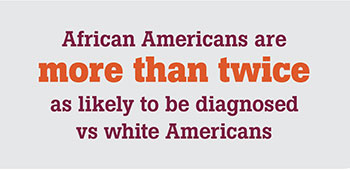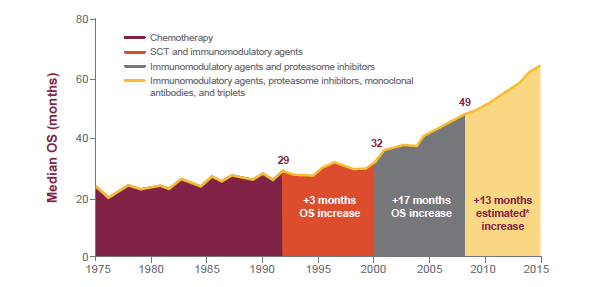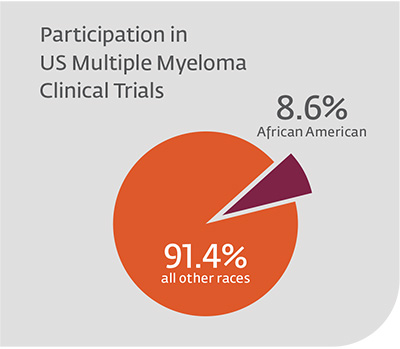
African Americans are more than twice as likely as their white counterparts to be diagnosed with multiple myeloma, and twice as likely to die from this form of cancer. Multiple myeloma treatment has advanced significantly in recent years, but survival rates for African American myeloma patients have not kept pace with survival rates of other myeloma patient populations. The reasons for these racial disparities are not known, but it is believed that the presence of some biological factors in African Americans may be the cause. There are also disparities in the care of African American myeloma patients such as issues relating to access to care and services, lack of awareness of risk factors and optimal treatment strategies. Studies have shown that when African American multiple myeloma patients receive prompt care and treatment, they can achieve the same results as other multiple myeloma patient populations.
What is Multiple Myeloma?
Multiple myeloma is a type of blood cancer that affects plasma cells. In multiple myeloma, malignant plasma cells accumulate in bone marrow — the soft, spongy tissue at the center of your bones — crowding out the normal plasma cells that help fight infection. These malignant plasma cells then produce an abnormal antibody called M protein, which offers no benefit to the body and may cause tumors, kidney damage, bone destruction and impaired immune function. The hallmark characteristic of multiple myeloma is a high level of M protein in the blood.
What Are the Signs and Symptoms of Multiple Myeloma?
Signs and symptoms of multiple myeloma aren’t always easy to recognize. Some people don’t experience any of the symptoms during the cancer’s earliest phases. As the cancer advances, symptoms vary greatly. One person’s experience can be completely different from someone else. When signs and symptoms do occur, they can include:

Multiple myeloma most often starts out as a relatively benign condition called monoclonal gammopathy of undetermined significance (MGUS). About 3% of people older than age 50 have MGUS in the United States. Each year, about 1% of people with MGUS develop multiple myeloma or a related cancer. MGUS, like multiple myeloma, is marked by the presence of M proteins — produced by abnormal plasma cells — in your blood. However, in MGUS, the levels of M proteins are lower and no damage to the body occurs.
Factors that may increase your risk of multiple myeloma include:
Multiple Myeloma in African Americans
African Americans have more than twice the incidence of multiple myeloma, compared to Whites. Even though multiple myeloma is the 2nd MOST common blood cancer in the United States, it is the MOST common blood cancer among African Americans. The African American population is expected to grow much more quickly than the white population. Because of this, the number of African Americans living with multiple myeloma is likely to increase. By 2034, it is estimated that African Americans will make up roughly 24% of the newly diagnosed multiple myeloma population. It is not completely understood why multiple myeloma is more common in African Americans - but generally there are some key facts about how multiple myeloma affects African Americans:

Some evidence suggests the biology of myeloma may be different in African Americans when compared to white Americans. Genetic studies are ongoing to better understand how myeloma may be different in African Americans. We do know, for example, that when African American patients are in clinical trials, they do just as well as white patients.

How is Multiple Myeloma Treated?
There is no cure for multiple myeloma. However, there are treatments that can help ease the pain, reduce complications, and slow the progression of the disease. Your doctor is unlikely to suggest treatment if you are not experiencing any symptoms. Instead, your doctor will closely monitor your condition for signs that the disease is progressing. This often involves regular blood and urine tests.
If you need treatment, common options include the following:
African Americans and Multiple Myeloma Treatment Disparities
Survival has improved in multiple myeloma over the last decade – more than almost any other cancer. Recent treatments have led to a doubling of overall survival of patients with this disease. Longer survival is a result of autologous stem cell transplants, enrollment in clinical trials, newer drugs, and using these drugs in combination. However, African Americans with multiple myeloma have benefited less from survival improvements in recent years. This might be because African Americans may not have had the same access to treatments. Based on a study of over 35,000 people, white Americans have gained 1.3 years of life compared to only 0.8 years of life for African Americans. Since 2008, the rates for the use of stem cell transplant have risen in the U.S. for myeloma patients, but not at the same rate for African Americans. African Americans are 37% less likely to undergo stem cell transplant even though this is the standard of care for eligible patients. In addition, socioeconomic status is associated with overall survival in myeloma patients.
African Americans and Clinical Trials

Clinical trials are important for new medicines to be approved by the US Food and Drug Administration (FDA). They have played a major role in advancing the treatment of multiple myeloma, and without these trials and the patients who voluntarily participated in them, we would not have the treatment options we have today. African Americans make up 20% of the people living with multiple myeloma today. Yet only 8.6% of patients in multiple myeloma clinical trials are African Americans, according to studies from 2000-2016. Therefore, it is important that African Americans are represented in clinical trials to better understand how they may be affected differently by multiple myeloma.
People who participate in clinical trials for a cancer drug will typically receive a current standard treatment or the new drug being studied. You are free to quit the trial at any time, for any reason at all including unwanted side effects of the treatment. If you are interested in learning more about clinical trials for multiple myeloma sign up for our email list to be alerted when a trial is enrolling in your area that might be a good fit.
When Multiple Myeloma Returns
Some cancers can be cured because they produce a mass that can be surgically removed or wiped out. On the other hand, multiple myeloma is a blood cancer. Treatment can help you achieve remission, but the disease doesn’t completely leave your body. The disease cannot be cured and though you may experience periods of remission a relapse can occur. A relapse is Multiple Myeloma that has come back after treatment. A person may also become refractory when their Multiple Myeloma does not respond to treatment.
A relapse can feature both physical signs and emotional side effects. Signs of a relapse can include:
Symptoms can return, blood cell counts can change, organs can have problems, or cancer growth may be evident. Remission is a time of uncertainty for people living with multiple myeloma. In the event of a recurrence, early diagnosis is critical. The best thing you can do for your health is keeping up with periodic testing. Therefore, because of the risk of relapse, ongoing appointments with your doctor are essential. There are many ways to attack recurrent multiple myeloma and achieve remission again.
Resources for Multiple Myeloma
Living with multiple myeloma, you are not alone. Meeting others who know exactly what you are experiencing can help you feel less alone. Reach out to people who understand your situation by joining an online or in-person support group.
The following websites include additional information about multiple myeloma.
Advocacy Groups
Online Communities/Facebook Groups
Cancer Information and Support